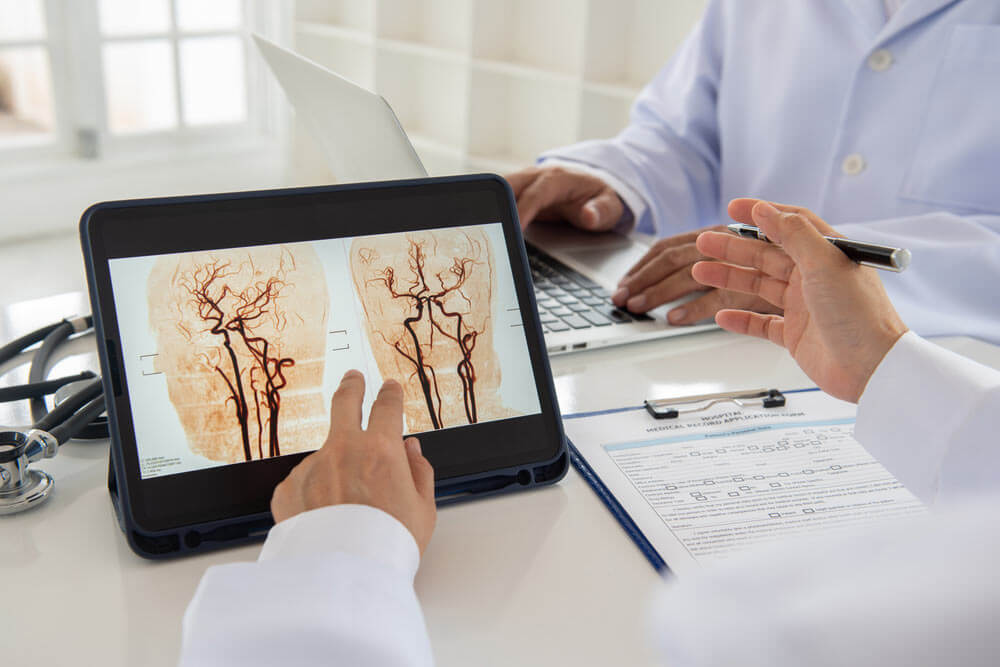A weakening in the wall of a blood vessel in your abdomen or sometimes in a leg which results in an abnormally dilated area. This dilated area is prone to:
- Clotting off and interrupting blood flow.
- Rupturing and causing serious bleeding.
- Compressing adjacent tissues.
USUALLY GENETIC, RARELY OCCUR
- Peripheral aneurysms are usually genetic; that is, you are born with the tendency to form them.
- Aneurysms in the abdomen, called splenic aneurysms, are uncommon, affecting 0.7% of the population.
- Peripheral aneurysms in the legs are very rare, affecting 0.007% of men, and even fewer women.
MAY REQUIRE TREATMENT
If you develop a peripheral aneurysm, it will not go away unless treated.
- Most peripheral aneurysms over 2 cm in diameter require treatment.
- In some cases even smaller aneurysms may require treatment
Symptoms
MAY BE ABSENT
Many peripheral aneurysms cause no symptoms and are found when your doctor does a physical or performs testing for other reasons.
ABDOMINAL PAIN, FAINTING
May indicate that a splenic aneurysm in your abdomen is causing bleeding.
SUDDEN PAIN, WEAKNESS, SWELLING, NUMBNESS IN THE LEG
May signal interrupted blood flow an aneurysm in your leg. In rare cases, may indicate compression of nearby nerves or compression of a vein next to the aneurysm.
PAINFUL, DISCOLORED TOE
“Blue toes” may indicate the presence of small blood clots washed down from elsewhere. This condition heals on its own in 2-3 months.
Causes
SOME SPECIFIC CAUSES OF PERIPHERAL ANEURYSMS INCLUDE:
- If family members have had an aneurysm you are more likely to have one.
- Having one peripheral aneurysm increases the risk of developing another one elsewhere.
- Smoking is the major controllable cause of aneurysm growth.
- For women, splenic aneurysms in the abdomen have a tendency to grow during pregnancy and are more common for mothers who have had many children.
Diagnosis
Peripheral aneurysms are often identified in a physical exam. If so, make an appointment to see a vascular surgeon.
TESTS MAY BE RECOMMENDED
- If a peripheral aneurysm is suspected, duplex ultrasound and computerized tomography (CT) scans are good tests to confirm its presence.
- If your vascular surgeon prescribes treatment, a computerized tomography (CT) angiography or catheter angiography may be needed.
Treatments
How best to treat an aneurysm depends on its location, the condition of surrounding blood vessels and other medical issues.
BYPASS SURGERY is one way to treat a peripheral aneurysm in your leg. First, blood flow is redirected around the aneurysm. Then, the aneurysm is removed or tied off to prevent circulating blood from continuing to fill the aneurysm.
STENT GRAFTING is used in some cases. During a catheterization procedure, a graft is placed inside the vein to seal off the aneurysm.
A SPLENIC ANEURYSM in your abdomen may be treated with embolization (occlusion) of the aneurysm, or with removal of the spleen.
Staying Healthy
Maintain a good cardiovascular lifestyle, including a low-saturated-fat diet and 30 minutes of some kind of aerobic activity at least five times per week.
- If you have family members with aneurysms, it is important for you to be checked.
- Smoking cessation is the best controllable way to prevent peripheral aneurysm growth.
- Manage cholesterol, blood pressure and blood sugar to healthy levels.
- If you are diagnosed with a peripheral aneurysm, ongoing follow-up with your vascular surgeon is critical.
